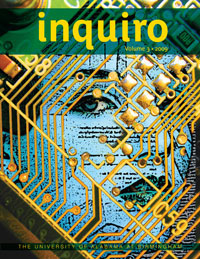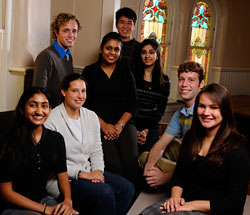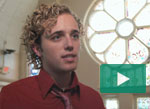Spreading the Word About Student Research
By Caperton Gillett
 |
The third edition of Inquiro debuts this month. Each issue features student art on the front and inside covers (click image for larger version) |
In 2007, junior chemistry major Suzanne McCluskey looked up from her lab bench and made a scientific observation: Motivated undergraduates at UAB had plenty of opportunities to conduct meaningful research but few outlets in which to share their results with the world. So she set about creating one.
McCluskey assembled an all-undergraduate editorial board, established editorial policies, and then made her case to Lowell Wenger, Ph.D., then dean of the School of Natural Sciences and Mathematics (now part of UAB's College of Arts and Sciences). Wenger readily offered his support, funding the necessary computers, printers, and software, and University Honors Program director Mike Sloane, Ph.D., provided an on-campus location for the enterprise. Everything else was left up to McCluskey and her team of fellow students.
Thus Inquiro was born—a full-color, 80-page undergraduate research publication that rivals the production values of many national scientific journals. Each edition of the annual journal—the third issue debuts this month—represents thousands of hours of effort on the part of the editorial staff, faculty reviewers, and undergraduate students who conduct the research and shape it into articles to share with their peers.
Publish and Flourish
“It’s a lot of work,” says Drew Buie, a junior chemistry major and current co-editor-in-chief of Inquiro. Students have to juggle their editorial responsibilities with their regular class schedules and other extracurricular activities, and some are working on their own research. Still, “it’s an amazing opportunity that every undergraduate should jump at,” offering invaluable experience for the future, Buie says.
 |
Inquiro's current editorial board: from left, Shweta Patel, Natalie Mitchell, Andrew Buie, Ashruta Patel, Timmy Wang, Toral Patel, Matt Morton, and Celeste Stuart (click image for larger version) |
“It takes a lot more work because it’s self-motivated,” adds Shweta Patel, a junior biology major and Buie’s co-editor-in-chief. “We don’t have a faculty member directly supervising us. We initiate the recruitment of submissions and the publication of the journal. We have to take our own time and make sure it’s done the right way.”
That drive will help these students stand out academically, Wenger says. “The students who participate on the editorial board are increasing their likelihood of getting into graduate school or a professional health school. They take the initiative to do things on their own with minimal supervision, which is something we always look for.”
Calling All Self-Starters
Recruiting submissions can be challenging, Patel says, because of the extra effort necessary to turn a scientific project into an article worthy of publication. Many of Inquiro’s contributors are undergraduate students who have already presented their findings at the annual UAB Expo research fair. “We contact them because they’ve already put the extra effort into making a poster or presentation, so the next step would be for them to submit a paper to the journal,” says Patel. “A lot of students are eager to publish because they know how much of a benefit it will be when they apply to graduate schools or professional schools.” And since the student researchers retain rights to the articles, they’re free to publish them in national journals as well.
“They’re able to say, ‘I researched, but I didn’t stop there. I published,’” Buie says. “They took the next step—not only discovering new things about the world or finding a solution to a problem, but also sharing it with others.”
Inquiro doesn’t just print research articles. It includes news briefs, feature stories, and faculty interviews written by members of the editorial staff. And while the research explores disciplines within the natural sciences and mathematics, the journal involves students across campus. For Inquiro’s first issue, the editorial board held a contest to find artwork for the front cover; since then, UAB student art has illustrated the front and inside covers of every issue.
“My hat is off to these individuals,” Wenger says. “They are an example of the outstanding students UAB is able to attract.” He adds that Inquiro’s success is due in part to the students’ creativity and inexperience; they aren’t pinned down by a concept of how things should be done. The faculty advisors do try to keep them apprised of potential pitfalls and challenges they may encounter, Wenger notes. “But they’re not deterred,” he says. “Thank goodness.”
To order a copy of Inquiro, contact the editorial staff at sciencejournal.Inquiro@gmail.com
